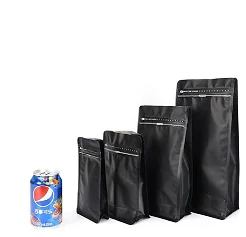The costs of different materials used in coffee bean bags can vary significantly depending on factors such as material type, quality, availability, and market demand.
Here’s a comparison of some common materials used in coffee bean bags and their relative costs:
- Paper: Paper bags are one of the most economical options for coffee bean packaging. They are widely available and cost-effective, especially for standard kraft paper bags. However, specialty papers with enhanced barrier properties or custom printing may incur higher costs.
- Polyethylene (PE) or Polypropylene (PP) Plastic: Plastic bags made from PE or PP are relatively inexpensive and offer good moisture resistance, making them suitable for coffee bean packaging. The cost of plastic bags can vary based on thickness, size, and printing complexity. Generally, thicker plastic bags or those with advanced features such as resealable zippers may be more expensive.
- Aluminum Foil: Aluminum foil bags provide excellent barrier properties against moisture, oxygen, and light, which helps preserve the freshness of coffee beans. However, aluminum foil is more costly compared to paper or plastic materials. The cost of aluminum foil bags depends on factors such as foil thickness, size, and printing requirements.
- Biodegradable or Compostable Materials: Biodegradable or compostable materials, such as bio-based plastics or compostable films, are environmentally friendly alternatives to traditional packaging materials. These materials may have higher upfront costs due to their eco-friendly attributes and limited availability compared to conventional materials.
- Multi-layer Laminates: Multi-layer laminates combine different materials to create packaging with enhanced barrier properties and durability. While effective for preserving coffee freshness, laminated bags tend to be more expensive than single-layer materials due to the complexity of production and the use of multiple layers.
- Specialty Films or Coatings: Specialty films or coatings, such as high-barrier films or oxygen scavengers, coffee beans bags can be added to packaging materials to improve shelf life and product protection. These advanced features typically come at an additional cost, making packaging materials with specialty films or coatings more expensive than standard options.
- Custom Printing and Branding: The cost of printing custom designs, logos, or branding elements on coffee bean bags varies depending on factors such as printing method, colors, and artwork complexity. Custom printing can significantly increase the overall cost of packaging materials but is essential for brand recognition and consumer appeal.
In summary, the costs of different materials used in coffee bean bags can vary widely depending on material type, quality, features, and customization options. While paper and standard plastics are generally more economical, specialty materials with enhanced barrier properties or eco-friendly attributes may incur higher costs. Manufacturers must consider various factors, including product requirements, branding objectives, budget constraints, and sustainability goals, when selecting packaging materials for coffee bean bags.

